Spatiotemporal Response of Hydrological Drought to Meteorological Drought on Multi-Time Scales Concerning Endorheic Basin
Abstract
:1. Introduction
2. Materials and Methods
2.1. Study Area and Data
2.1.1. Study Area
2.1.2. Data
2.2. Methodology
2.2.1. Standardized Precipitation Index (SPI)
2.2.2. Standardized Terrestrial Water Storage Index (SWSI)
2.2.3. Ensemble Empirical Mode Decomposition (EEMD)
- (1)
- First, add the white noise of the specified amplitude to the original signal:
- (2)
- According to the principle of EMD decomposition, the signal after the addition of the white noise is decomposed to obtain the component IMF1.
- (3)
- The same white noise is added to the signal after decomposing the component IMF1, and the new signal will continue to be decomposed according to the decomposition principle of EMD to acquire the component IMF2.
- (4)
- The above steps will be repeated to derive multiple component IMFs, and the average of these components will then be used as the final result so that the white noise can be eliminated as exhibited in the following formula:
- (5)
- Thereafter, different component IMFs and trend terms can be extracted and the signal reconstructed, as shown below:
2.2.4. Cross Wavelet Transform (CWT)
2.2.5. Time Lag Cross-Correlation
2.2.6. Correlation Analysis
3. Results
3.1. The Spatiotemporal Variations of Meteorological Drought and Hydrological Drought
3.2. The Temporal Response of Hydrological Drought to Meteorological Drought
3.3. The Spatial Response of Hydrological Drought to Meteorological Drought
4. Discussion
5. Conclusions
- Meteorological drought and hydrological drought all showed a trend of getting weak from 1960 to 2014, and the variation trend of hydrological drought is more obvious than that of meteorological drought before 1980, while the opposite is true after 1980. In space, meteorological drought depicted an overall weakening trend, while hydrological drought showed a weakening trend in plain areas and an increasing trend in desert areas; the change was not obvious in mountainous areas.
- Meteorological and hydrological drought have significant resonance periods on the 10-month time scale and the 8-year time scale. The correlation between meteorological drought and hydrological drought is not stable in the resonance period at the short time scale, while it is stable at the long time scale.
- Hydrological drought develops in different time scales and spatial distributions in the study region. Additionally, it is particularly important that different responses develop in the lowland and mountainous parts, suggesting that we need to approach the two topographic situations differently.
Author Contributions
Funding
Institutional Review Board Statement
Informed Consent Statement
Data Availability Statement
Conflicts of Interest
References
- Wilhite, D.A.; Glantz, M.H. Understanding the drought phe-nomenon: The role of definitions. Water Int. 1985, 10, 111–120. [Google Scholar] [CrossRef] [Green Version]
- Ping, L.; Nina, O.; Indrajeet, C.; Wei, X. Evaluation of Drought Implications on Ecosystem Services: Freshwater Provisioning and Food Provisioning in the Upper Mississippi River Basin. Int. J. Environ. Res. Pub. Health 2017, 14, 496. [Google Scholar] [CrossRef] [Green Version]
- Li, J. Unknowable Records of 5000-Year Disasters; Wuhan Publishing House: Wuhan, China, 2020. [Google Scholar]
- Wilhite, D.A. Drought as a Natural Hazard: Concepts and Definitions//Wilhite D. Drought: A Global Assessment; Routledge: New York, NY, USA, 2000; pp. 1–18. [Google Scholar]
- Dai, A. Drought under global warming: A review. Clim. Chang. 2011, 2, 45–65. [Google Scholar] [CrossRef] [Green Version]
- Zhang, Q.; Singh, V.P.; Li, J.; Jiang, F.; Bai, Y. Spatio-temporal variations of precipitation extremes in Xinjiang, China. J. Hydrol. 2012, 434–435, 7–18. [Google Scholar] [CrossRef]
- Xu, J.; Chen, Y.; Li, W.; Liu, Z.; Tang, J.; Wei, C. Understanding temporal and spatial complexity of precipitation distribution in Xinjiang, China. Theor. Appl. Climatol. 2016, 123, 321–333. [Google Scholar] [CrossRef]
- Chen, Y.; Deng, H.; Li, B.; Zhi, L.; Xu, C. Abrupt change of temperature and precipitation extremes in the arid region of Northwest China. Quat. Int. 2014, 336, 35–43. [Google Scholar] [CrossRef]
- Li, J.; Guo, Y.; Wang, Y.; Lu, S.; Chen, X. Drought propagation patterns under naturalized condition using daily hydrometeorological data. Adv. Meteorol. 2018, 2018, 2469156. [Google Scholar] [CrossRef]
- Ma, F.; Luo, L.; Ye, A.; Duan, Q. Drought characteristics and propagation in the semiarid Heihe River Basin in Northwestern China. J. Hydrol. 2018, 20, 59–77. [Google Scholar] [CrossRef]
- Huang, S.; Li, P.; Huang, Q.; Leng, G.; Hou, B.; Ma, L. The propagation from meteorological to hydrological drought and its potential influence factors. J. Hydrol. 2017, 547, 184–195. [Google Scholar] [CrossRef]
- Lorenzo-Lacruz, J.; Vicente-Serrano, S.M.; González-Hidalgo, J.C.; López-Moreno, J.I.; Cortesi, N. Hydrological drought response to meteorological drought in the Iberian Peninsula. Clim. Res. 2013, 58, 117–131. [Google Scholar] [CrossRef] [Green Version]
- Van Lanen, H.A.J.; Wanders, N.; Tallaksen, L.M.; Van Loon, A.F. Hydrological drought across the world: Impact of climate and physical catchment structure. Hydrol. Earth. Syst. Sci. 2013, 17, 1715–1732. [Google Scholar] [CrossRef] [Green Version]
- Xu, Y.; Zhang, X.; Wang, X.; Hao, Z.; Hao, F. Propagation from meteorological drought to hydrological drought under the impact of human activities: A case study in northern China. J. Hydrol. 2019, 579, 124147. [Google Scholar] [CrossRef]
- Zhou, J.; Li, Q.; Wang, L.; Lei, L.; Zhu, G. Impact of climate change and land-use on the propagation from meteorological drought to hydrological drought in the Eastern Qilian Mountains. Water 2019, 11, 1602. [Google Scholar] [CrossRef] [Green Version]
- Zhao, L.; Lyu, A.; Wu, L.; Hayes, M.; Tang, Z. Impact of meteorological drought on streamflow drought in Jinghe River Basin of China. Chin. Geogr. Sci. 2014, 24, 694–705. [Google Scholar] [CrossRef]
- Sun, P.; Zhang, Q.; Singh, V.P.; Xiao, M.; Zhang, X. Transitional variations and risk of hydro-meteorological droughts in the Tarim River basin, China. Stoch. Environ. Res. Risk. Assess. 2017, 31, 1515–1526. [Google Scholar] [CrossRef]
- Zhu, N.; Xu, J.; Li, W.; Li, K.; Zhou, C. A comprehensive approach to assess the hydrological drought of inland river basin in Northwest China. Atmosphere 2019, 9, 370. [Google Scholar] [CrossRef] [Green Version]
- Zhu, N.; Xu, J.; Wang, C.; Chen, Z.; Luo, Y. Modeling the multiple time scale response of hydrological drought to climate change in the data-scarce inland river basin of Northwest China. Arab. J. Geosci. 2019, 12, 225. [Google Scholar] [CrossRef]
- Tao, H.; Gemmer, M.; Bai, Y.; Su, B.; Mao, W. Trends of streamflow in the Tarim River Basin during the past 50 years: Human impact or climate change? J. Hydrol. 2011, 400, 1–9. [Google Scholar] [CrossRef]
- Wang, A.; Zeng, X. Evaluation of multireanalysis products with in situ observations over the Tibetan Plateau. J. Geophys. Res. 2012, 117. [Google Scholar] [CrossRef]
- McKee, T.; Doesken, N.; Kleist, J. The relationship of drought frequency and duration to time scales. Preprints. In Proceedings of the Eighth Conference on Applied Climatology, Anaheim, CA, USA, 17–22 January 1993; pp. 179–184. [Google Scholar]
- Vicente-Serrano, S.M.; Beguería, S.; López-Moreno, J.I. A Multiscalar Drought Index Sensitive to Global Warming: The Standardized Precipitation Evapotranspiration Index. J. Clim. 2010, 23, 1696–1718. [Google Scholar] [CrossRef] [Green Version]
- Palmer, W.C. Meteorological Droughts; U.S. Department of Commerce, Weather Bureau Research Paper 45; US Department of Commerce Weather Bureau: Washington, DC, USA, 1965; p. 58.
- Zhai, J.; Su, B.; Krysanova, V.; Vetter, T.; Gao, C.; Jiang, T. Spatial variation and trends in PDSI and SPI indices and their relation to streamflow in 10 large regions of China. J. Clim. 2010, 23, 649–663. [Google Scholar] [CrossRef]
- Tao, H.; Borth, H.; Fraedrich, K.; Su, B.; Zhu, X. Drought and wetness variability in the Tarim River Basin and connection to large-scale atmospheric circulation. Int. J. Climatol. 2014, 34, 2678–2684. [Google Scholar] [CrossRef]
- Yang, P.; Xia, J.; Zhang, Y.; Han, J.; Wu, X. Quantile regression and clustering analysis of standardized precipitation index in the Tarim River Basin, Xinjiang, China. Theor. Appl. Climatol. 2018, 134, 901–912. [Google Scholar] [CrossRef]
- Zhang, Q.; Sun, P.; Li, J.; Xiao, M.; Singh, V.P. Assessment of drought vulnerability of the Tarim River basin, Xinjiang, China. Theor. Appl. Climatol. 2015, 121, 337–347. [Google Scholar] [CrossRef]
- Wang, H.; Chen, Y.; Pan, Y.; Chen, Z.; Ren, Z. Assessment of candidate distributions for SPI/SPEI and sensitivity of drought to climatic variables in China. Int. J. Climatol. 2019, 39, 4392–4412. [Google Scholar] [CrossRef]
- Wang, Q.; Shi, P.; Lei, T.; Geng, G.; Liu, L.; Mo, X.; Li, X.; Zhou, H.; Wu, J. The alleviating trend of drought in the Huang-Huai-Hai Plain of China based on the daily SPEI. Int. J. Climatol. 2015, 35, 3760–3769. [Google Scholar] [CrossRef]
- Shukla, S.; Wood, A.W. Use of a standardized runoff index for characterizing hydrologic drought. Geophys. Res. Lett. 2008, 35. [Google Scholar] [CrossRef] [Green Version]
- Xu, J.; Chen, Y.; Li, W.; Liu, Z.; Wei, C.; Jieet, T. Understanding the complexity of temperature dynamics in Xinjiang, China, from multitemporal scale and spatial perspectives. Sci. World. J. 2013, 2013, 259248. [Google Scholar] [CrossRef]
- Xu, J.; Chen, Y.; Li, W.; Ji, M.; Dong, S.; Hong, Y. Wavelet analysis and nonparametric test for climate change in Tarim River Basin of Xinjiang during 1959–2006. Chin. Geogr. Sci. 2009, 19, 306–313. [Google Scholar] [CrossRef] [Green Version]
- Wu, Z.; Huang, N.E. Ensemble Empirical Mode Decomposition: A noise-assisted data analysis method. Adv. Adapt. Data. Anal. 2009, 1, 1–41. [Google Scholar] [CrossRef]
- Xu, J.; Chen, Y.; Bai, L.; Xu, Y. A hybrid model to simulate the annual runoff of the Kaidu River in northwest China. Hydrol. Earth. Syst. Sci. 2016, 20, 1447–1457. [Google Scholar] [CrossRef] [Green Version]
- Grinsted, A.; Moore, J.C.; Jevrejeva, S. Application of the cross wavelet transform and wavelet coherence to geophysical time series. Nonlin. Processes. Geophys. 2004, 11, 561–566. [Google Scholar] [CrossRef]
- Kumar, P.; Foufoula-Georgiou, E. Wavelet analysis for geophysical applications. Rev. Geophys. 1997, 35, 385–412. [Google Scholar] [CrossRef] [Green Version]
- Torrence, C.; Compo, G.P. A practical guide to wavelet analysis. Am. Meteorol. Soc. 1998, 79, 61–78. [Google Scholar] [CrossRef] [Green Version]
- Kraemer, T.; Johnsen, H.; Brekke, C.; Engen, G. Comparing SAR-Based Short Time-Lag Cross Correlation and Doppler-Derived Sea Ice Drift Velocities. IEEE Trans. Geosci. Remote Sens. 2017, 56, 1898–1908. [Google Scholar] [CrossRef]
- Liu, X.; Xu, Z.; Yu, R. Spatiotemporal variability of drought and the potential climatological driving factors in the Liao River basin. Hydrol. Process. 2012, 26, 1–14. [Google Scholar] [CrossRef]
- Zhang, W. Study on the change of meteorological elements in Tarim River basin in recent 50 years. Water Power 2020, 46, 28–34. [Google Scholar]
- Wu, J.; Miao, C.; Zheng, H.; Duan, Q.; Lei, X.; Li, H. Meteorological and hydrological drought on the Loess Plateau, China: Evolutionary characteristics, impact, and propagation. J. Geophys. Res. Atmos. 2018, 123, 11569–11584. [Google Scholar] [CrossRef]
- Kriesche, B.; Chaput, M.A.; Kulik, R.; Gajewski, K.; Schmidt, V. Estimation of spatio-temporal correlations of prehistoric population and vegetation in North America. Geogr. Anal. 2019, 52, 371–393. [Google Scholar] [CrossRef]
- Liu, S.; Ding, Y.; Shangguan, D.; Li, J.; Han, H.; Wang, J.; Xie, C. Glacier retreat as a result of climate warming and increased precipitation in the Tarim River basin, northwest China. Ann. Glaciol. 2006, 43, 91–96. [Google Scholar] [CrossRef] [Green Version]
- Chen, Y.; Xu, C.; Hao, X.; Li, W.; Chen, Y.; Zhu, Z.; Ye, Z. Fifty-year climate change and its effect on annual runoff in the Tarim River basin, China. Quart. Int. 2009, 208, 53–61. [Google Scholar] [CrossRef]
- Barker, L.J.; Hannaford, J.; Chiverton, A.; Svensson, C. From meteorological to hydrological drought using standardised indicators. Hydrol. Earth. Syst. Sci. 2016, 20, 2483–2505. [Google Scholar] [CrossRef] [Green Version]
- Wu, J.; Liu, Z.; Yao, H.; Chen, X.; Chen, X.; Zheng, Y.; He, Y. Impacts of reservoir operations on multi-scale correlations between hydrological drought and meteorological drought. J. Hydrol. 2018, 563, 726–736. [Google Scholar] [CrossRef]
- Li, J.; Wu, C.; Xia, C.A.; Yeh, J.F.; Huang, G. Assessing the responses of hydrological drought to meteorological drought in the Huai River Basin, China. Theor. Appl. Climatol. 2021, 144, 1043–1057. [Google Scholar] [CrossRef]
- Wang, F.; Wang, Z.; Yang, H.; Di, D.; Hussain, Z. Comprehensive evaluation of hydrological drought and its relationships with meteorological drought in the Yellow River basin, China. J. Hydrol. 2020, 584, 124751. [Google Scholar] [CrossRef]
- Zhu, N. Comprehensive Assessment of Drought in the Tarim River Basin Based on GLDAS and GRACE; East China Normal University: Shanghai, China, 2020. [Google Scholar]
- Wu, J. The Response of Hydrological Drought to Meteorological Drought and the Impact of Large-Scale Reservoirs; Fujian Normal University: Fuzhou, China, 2017. [Google Scholar]
- Hellwig, J.; Graaf, I.E.M.D.; Weiler, M.; Stahl, K. Large-Scale Assessment of Delayed Groundwater Responses to Drought. Water Resour. Res. 2020, 56, e2019WR025441. [Google Scholar] [CrossRef] [Green Version]
- Van Loon, A.F.; Gleeson, T.; Clark, J.; Van Dijk, A.I.; Stahl, K.; Hannaford, J.; Di Baldassarre, G.; Teuling, A.J.; Tallaksen, L.M.; Uijlenhoet, R.; et al. Drought in the anthropocene. Nat. Geosci. 2016, 9, 89–91. [Google Scholar] [CrossRef] [Green Version]
- Wu, J.F.; Chen, X.W.; Love, C.; Yao, H.; Chen, X.; AghaKouchak, A. Determination of water required to recover from hydrological drought: Perspective from drought propagation and non-standardized indices. J. Hydrol. 2020, 590, 125227. [Google Scholar] [CrossRef]
- Su, B.; Wang, A.; Wang, G.; Wang, Y.; Tong, J. Spatiotemporal variations of soil moisture in the Tarim River basin, China. Int. J. Appl. Earth Obs. 2016, 48, 122–130. [Google Scholar] [CrossRef]
- Huang, S.; Wang, L.; Wang, H.; Huang, Q.; Leng, G.; Fang, W.; Zhang, Y. Spatio-temporal characteristics of drought structure across China using an integrated drought index. Agric. Water Manag. 2019, 218, 182–192. [Google Scholar] [CrossRef]

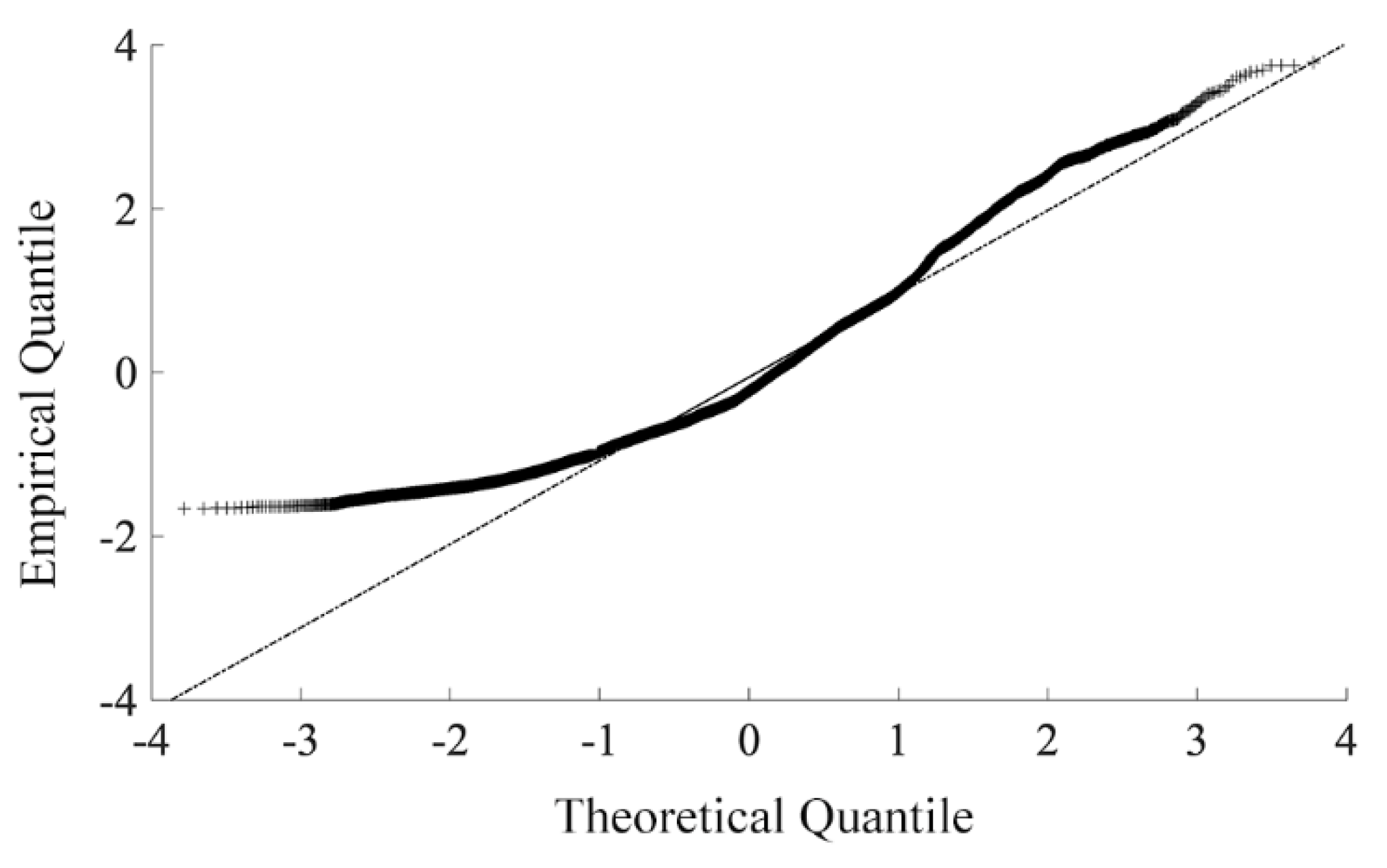
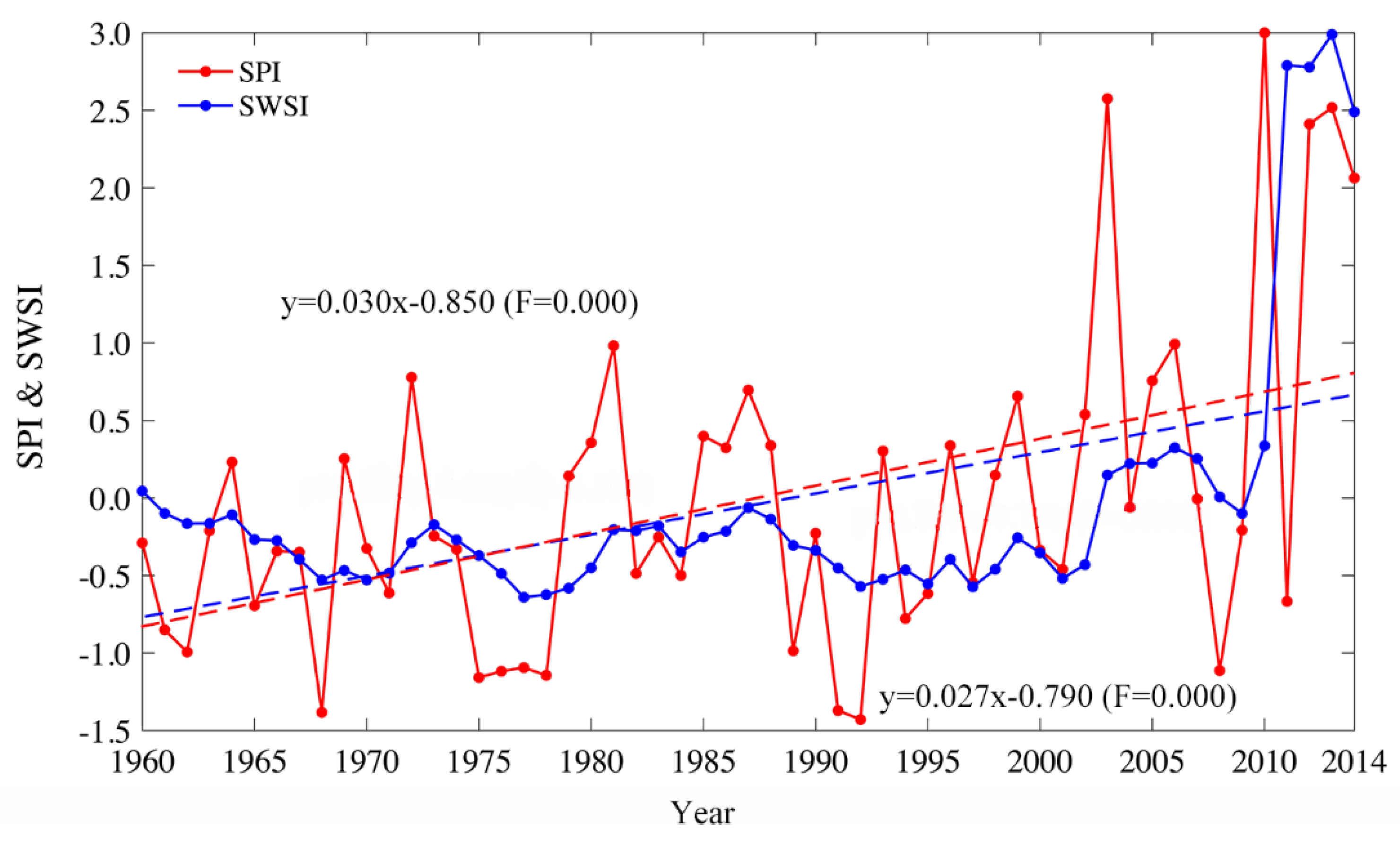
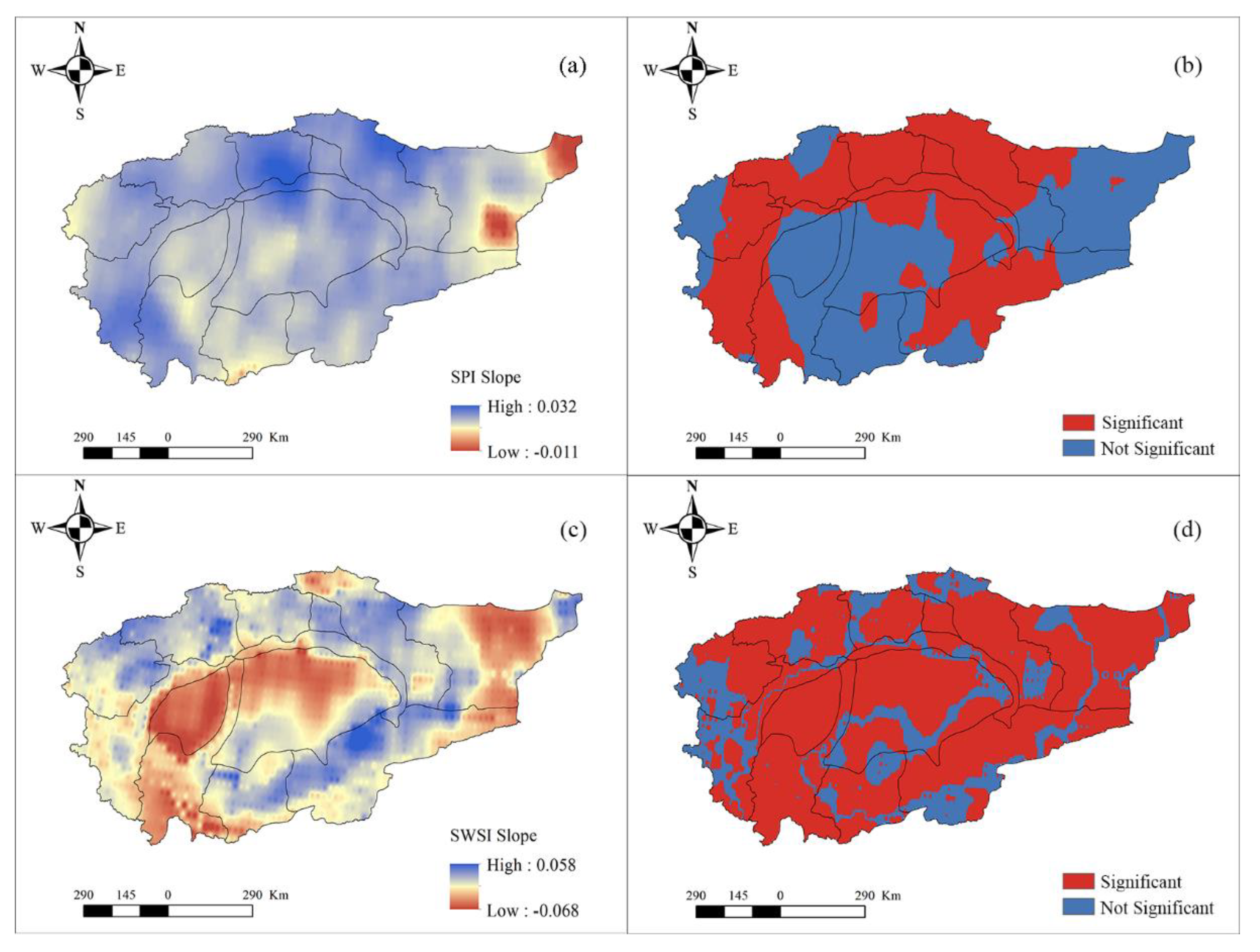
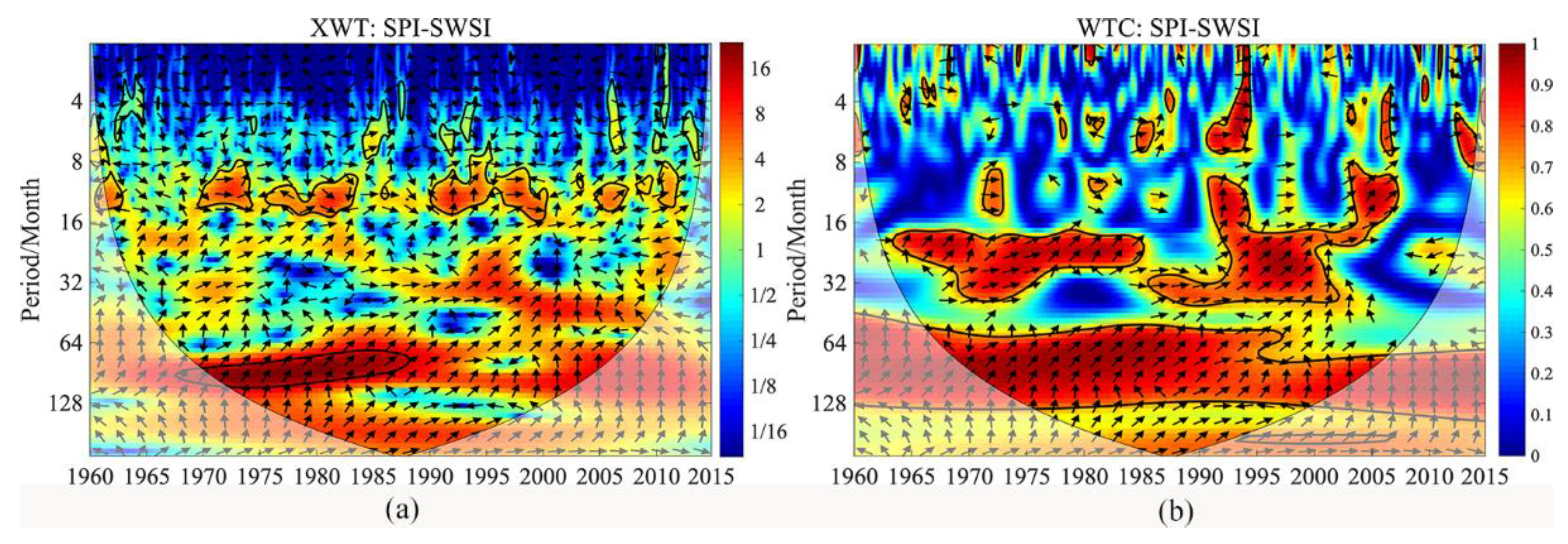

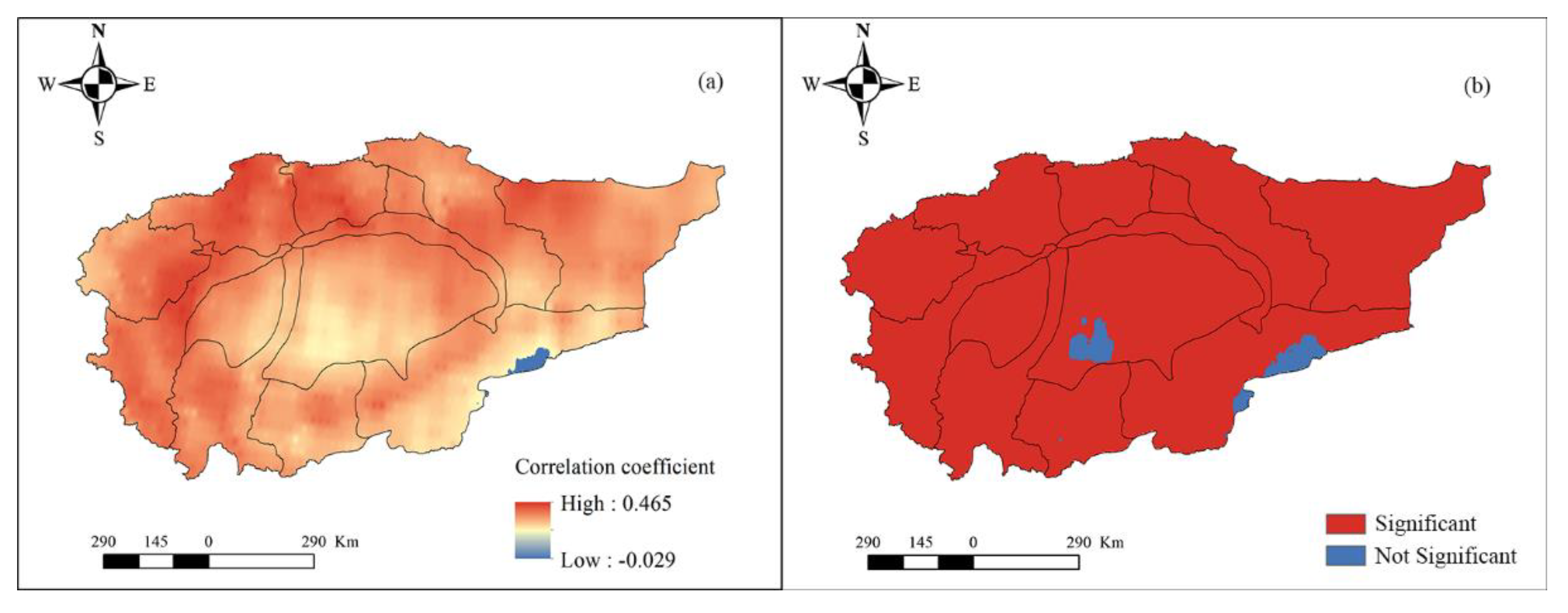

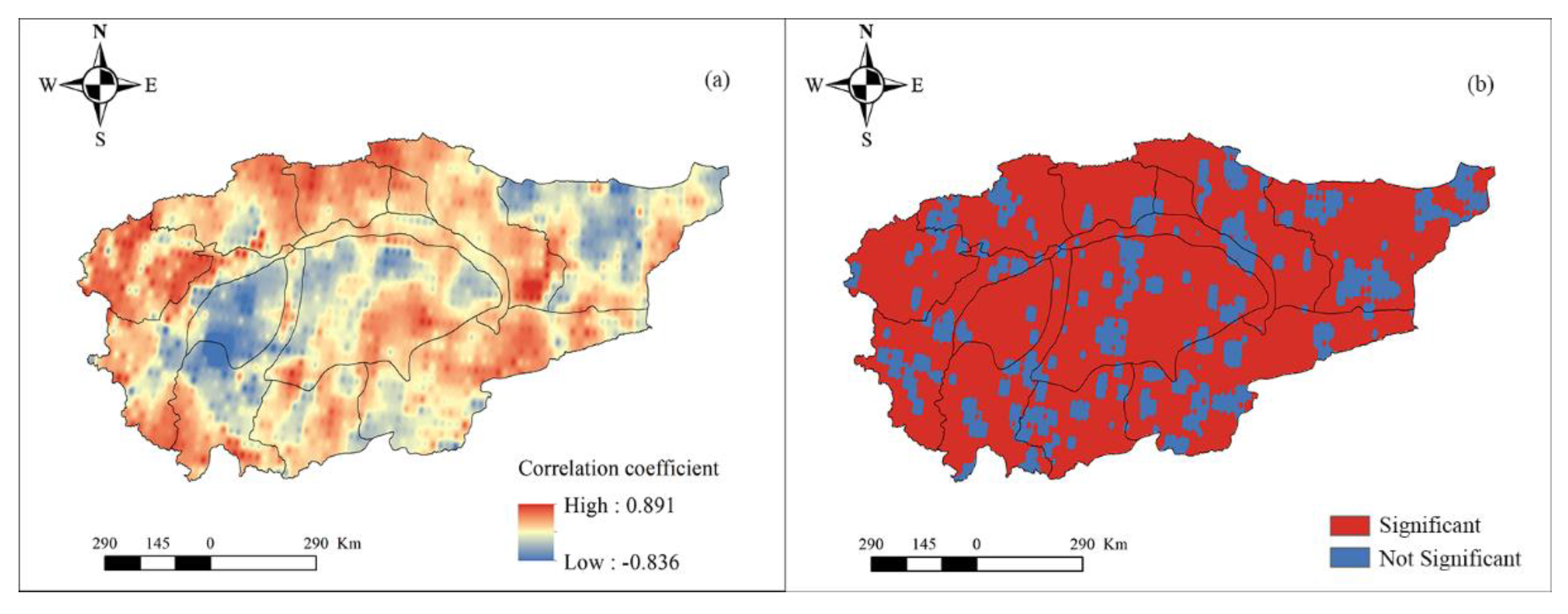
| Category | SPI Value |
|---|---|
| Normal | −0.5 < SPI |
| Mild drought | −1 < SPI ≤ −0.5 |
| Moderate drought | −1.5 < SPI ≤ −1 |
| Severe drought | −2 < SPI ≤ −1.5 |
| Extreme drought | −2 ≥ SPI |
| Correlation Coefficient | p-Value | |
|---|---|---|
| Year | 0.554 *** | 0.000 |
| Spring | 0.456 *** | 0.000 |
| Summer | 0.289 *** | 0.000 |
| Autumn | 0.232 *** | 0.003 |
| Winter | 0.197 ** | 0.012 |
Publisher’s Note: MDPI stays neutral with regard to jurisdictional claims in published maps and institutional affiliations. |
© 2021 by the authors. Licensee MDPI, Basel, Switzerland. This article is an open access article distributed under the terms and conditions of the Creative Commons Attribution (CC BY) license (https://creativecommons.org/licenses/by/4.0/).
Share and Cite
Zhu, N.; Xu, J.; Zeng, G.; Cao, X. Spatiotemporal Response of Hydrological Drought to Meteorological Drought on Multi-Time Scales Concerning Endorheic Basin. Int. J. Environ. Res. Public Health 2021, 18, 9074. https://doi.org/10.3390/ijerph18179074
Zhu N, Xu J, Zeng G, Cao X. Spatiotemporal Response of Hydrological Drought to Meteorological Drought on Multi-Time Scales Concerning Endorheic Basin. International Journal of Environmental Research and Public Health. 2021; 18(17):9074. https://doi.org/10.3390/ijerph18179074
Chicago/Turabian StyleZhu, Nina, Jianhua Xu, Gang Zeng, and Xianzhong Cao. 2021. "Spatiotemporal Response of Hydrological Drought to Meteorological Drought on Multi-Time Scales Concerning Endorheic Basin" International Journal of Environmental Research and Public Health 18, no. 17: 9074. https://doi.org/10.3390/ijerph18179074
APA StyleZhu, N., Xu, J., Zeng, G., & Cao, X. (2021). Spatiotemporal Response of Hydrological Drought to Meteorological Drought on Multi-Time Scales Concerning Endorheic Basin. International Journal of Environmental Research and Public Health, 18(17), 9074. https://doi.org/10.3390/ijerph18179074







